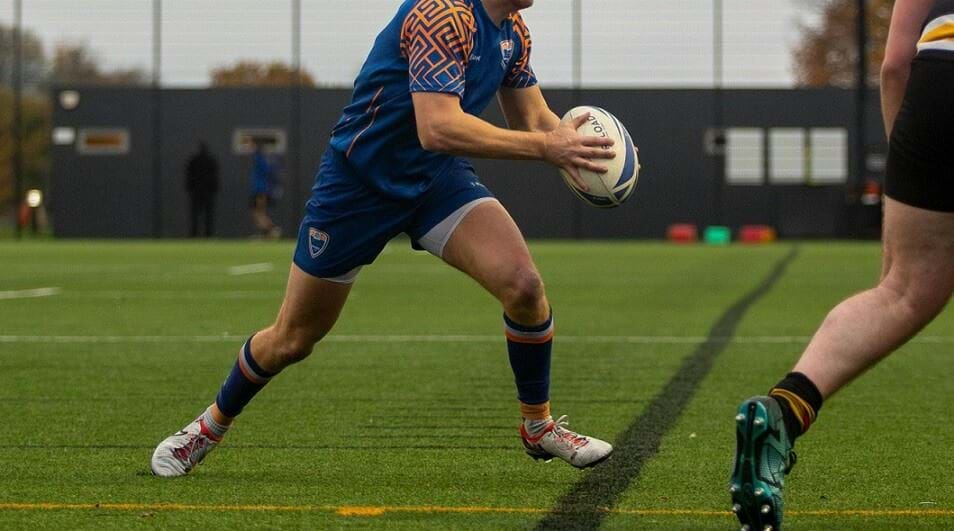Gym Workout Routines for Rugby Players

Gym Training For Rugby | Fitness Components | Training Plan | Exercises | Example Workout | Rugby Season | FAQs
Playing rugby, whether professionally or for fun, demands a unique combination of strength, power, speed, and endurance. While playing rugby helps to hone these skills, training in the gym will help you to become a faster, fitter, more powerful player on the pitch, while also helping to protect against injuries.
Here, professional ruby player and PureGym PT Mo Agoro shares everything you need to know about gym training for rugby players.
Why is Gym Training Essential for Rugby Players?
The modern rugby player needs more than drills and match practice to excel on the field. While these are great for building initial performance, having a rugby-specific gym programme is key to take your performance to the next level by:
- Enhancing physical resilience to handle contact and collisions.
- Building explosive power for sprinting, tackling, and jumping.
- Improving speed, agility, and endurance for both offense and defence.
- Supporting injury prevention by strengthening key muscle groups and stabilising joints.
- Boosting overall performance and endurance.
What Are the Key Fitness Components for Rugby Performance?
Your gym plan for rugby player development should focus on six key elements that develop all the skills you need on the pitch:
Speed. Prioritise explosive drills that include sprints and change of direction.
Strength. Compound lifts to build functional strength for scrums, tackles, and mauls.
Power. Explosive moves like Olympic lifts, jumps, throws for speed and acceleration.
Cardio. Incorporate aerobic and anaerobic conditioning to sustain performance during games.
Core stability. Develop trunk strength for balance, rotational power, and protection during contact.
Isolation movements. Address lagging muscle groups, improve symmetry, reduce injury risk.
Gym for Rugby: Building Your Training Plan
Just like rugby itself, your gym training plan should be periodised to reflect the demands of off-season, pre-season, in-season, and taper. This helps to avoid overtraining and ensure that your gym sessions don’t negatively impact your rugby performance.
Off-season (building strength and power)
- Goal: Maximise strength, power, and size while maintaining conditioning.
- Gym: 3-4 sessions per week, higher volume, progressive overload focus.
- Rugby-specific conditioning: Sprint work, aerobic base development.
Pre-season (rugby-specific development)
- Goal: Convert strength into power and speed while building match fitness.
- Gym: 3-4 sessions per week, shift towards explosive movements, reduce volume.
- Rugby-specific conditioning: HIIT, anaerobic repeat sprint ability, change of direction drills.
In-season (maintenance and injury prevention)
- Goal: Maintain strength, power, and speed without negatively impacting rugby performance.
- Gym: 2-3 sessions per week, lower volume, higher intensity, reduced eccentric loading to minimize soreness.
- Rugby-Specific Conditioning: Mostly from rugby training and games, but some top-up sprint work.
Taper (leading into key games or playoffs)
- Goal: Keep power and speed high while reducing fatigue.
- Gym: 1-2 short, explosive sessions per week.
- Rugby-Specific Conditioning: Very limited; focus on recovery.
15 Of The Best Gym Exercises for Improving Rugby
Strength, power, and speed have a huge impact on rugby performance, and the best gym programme for rugby players will help to build these areas with a combination of compound movements, explosive exercises, and sprint work.
Strength exercises
One of the best ways to build strength is through heavy weightlifting. Performing compound (multi joint) exercises with high weight, low reps is a very effective way to increase full body strength quickly.
Some of the best compound exercises to include are:
Barbell squats. Builds strength in the lower body, particularly the quads.
Conventional deadlifts. Strengthens the posterior chain, including the hamstrings, glutes, and lower back.
Bench press. Works the chest, triceps, and shoulders.
Barbell bent over rows. Strengthens the back, shoulders, and biceps.
Barbell shoulder press. Works the shoulders and upper back.
Choose a weight that you can lift with good form for no more than 5-8 reps and perform this for 3-5 sets. Make sure to increase the weight as you get stronger.
Exercises for power
Incorporating plyometric exercises into your training helps to build explosive power. Include exercises which develop full body power, such as:
- Hang cleans: Olympic weightlifting movement that builds full-body explosive power.
- Medicine ball overhead throws: Develops upper-body explosiveness.
- Broad jumps: Enhances horizontal power and takeoff strength.
- Box jumps: Improves vertical jumping power.
- Medicine ball rotational throws: Builds rotational power.
Learn more about plyometric training here.
Exercises for speed
- Acceleration sprints: Short sprints (10-20m) focusing on rapid starts.
- Top-end speed sprints: Longer sprints (30-40m) to develop max velocity.
- Hill sprints: Builds explosive power and drive.
- Resisted sprints: Using a sled or resistance band to improve drive phase.
- Sprint with change of direction: Sprint, decelerate, and change direction quickly.
Example Gym Workout Plan for Rugby Players
Mo has put together this sample rugby workout that balances strength, power, and conditioning work, that can be used as one of your weekly training sessions.
Warm-Up
- Leg swings (front and side) - 10 reps per leg
- World's greatest stretch - 5 reps per side
- Banded lateral walks - 2 x 15 steps each way
- Cat-cow stretch - 2 x 8 reps
- Medicine ball rotational throws - 2 sets x 3 reps per side
Main Workout
1a) Zercher squats - 3 sets x 5 reps
1b) Broad jumps - 3 sets x 3 reps (immediately after squats)
Rest: 2 minutes after each contrast set
- Bench press - 3 sets x 8 reps
Rest: 2 minutes between sets
Accessory Superset
3a) Dumbbell Romanian deadlifts (RDLs) - 3 sets x 10 reps
3b) Lat pull down - 3 sets x 10 reps
Rest: 2 minutes between supersets
4) Pallof press - 3 sets x 8 reps each side
Rest: 2 minutes between sets
Cardio Finisher
Bike intervals:
30 seconds at a moderate-to-high effort
30 seconds easy pace
Repeat for 8-12 rounds
This finisher improves aerobic capacity, which is critical for sustaining performance throughout matches, and will help with recovery too. Even if it might not feel like it at the time!
How to Balance Gym Training with On-Field Practice
As a rugby player, you can’t spend all of your time and energy in the gym. When you’re also doing team practice or friendlies, you’ll need to balance gym training with rugby. Here’s how to do it.
As a rugby player, you need to balance gym training with rugby sessions to avoid fatigue while still improving strength, power, and speed. Here’s how to do it throughout the year:
Pre-season (8-12 weeks)
3-4 gym sessions per week
Focus on strength, power, and speed development
Introduce rugby-specific conditioning (sprint work, change of direction, anaerobic capacity)
Gradually increase intensity while managing fatigue
In-season (competitive phase)
- 2-3 gym sessions per week
- Maintain strength and power (lower volume, keep intensity high)
- Prioritize explosive movements and injury prevention work
- Avoid excessive fatigue - gym work should complement on-field performance
Off-season (rebuilding phase)
- 3-4 gym sessions per week
- Address weaknesses (e.g., mobility, structural imbalances, size)
- Build aerobic and strength base for next season
- Volume can be higher since rugby demands are lower
FAQs About Rugby Player Gym Training
During pre-season, aim for 3-4 sessions per week. During the season, reduce to 2-3 quality sessions.
Yes, rugby players should include both high-intensity interval training (HIIT) for match-specific conditioning and steady-state aerobic work to build a strong aerobic base. A well-developed aerobic system improves recovery between efforts, enhances work capacity, and supports long-term performance.
The fundamental training principles for backs and forwards should be the same. All rugby players need to develop strength, power, speed, and robustness to perform at their best. A well-structured program should include:
Strength and power: Squats, deadlifts, Olympic lifts, and pressing movements to build maximal force production.
Speed and explosiveness: Sprint work, plyometrics, and acceleration drills to improve on-field performance.
Robustness and injury prevention: Core stability, neck strengthening, mobility work, and aerobic conditioning to enhance durability and endurance.
Ready to take your rugby performance to the next level? Working with a Personal Trainer like Mo who can create a rugby training plan for the gym is a great option. Find your nearest PureGym to get started today.


